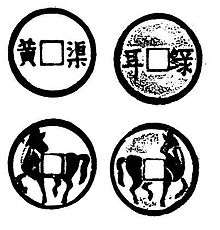Horse coin


Horse coins (Traditional Chinese: 馬錢; Simplified Chinese: 马钱; Pinyin: mǎ qián) are a type of Chinese numismatic charm that originated in the Song dynasty presumably as gambling tokens although many literary figures wrote about these coins their usage has always been failed to be mentioned by them, most horse coins tend to be round coins 3 centimeters in diameter with a circular or square hole in the middle of the coin. The horses featured on horse coins are depicted in various positions such as lying on the ground sleep, turning their head while neighing, or galloping forward with their tails rising high. it is currently unknown how horse coins were actually used though it is speculated that Chinese horse coins were actually used as game board pieces or gambling counters. Horse coins are most often manufactured from copper or bronze, but in a few documented cases they may also be made from animal horns or ivory. The horse coins produced during the Song dynasty are considered to be those of the best quality and craftsmanship and tend be made from better metal than the horse coins produced after.[1][2] Some horse coins would feature the name of the famous horses they depicted. It is estimated that there are over three hundred variants of the horse coin.[3][4][5] Some horse coins contained only an image of a horse while others also included an image of the rider and others had inscriptions which identify the horse or rider. During the beginning of the year of the horse in 2002 Chinese researchers Jian Ning and Wang Liyan of the National Museum of Chinese History wrote articles on horse coins the "China Cultural Relics Newspaper", the researchers noted that they found it a pity that the holes in the coins covered the saddles of the horses as this could've revealed more about ancient horse culture. Horse coins from the Song dynasty are the horse coins that are produced at the highest quality while horse coins from subsequent dynasties tend to be inferior compared to them.[6]
Horse coins often depicted famous horses from Chinese history or famous horses from Chinese mythology, while commemorative horse coins would also feature riders, such as the horse coin that features “General Yue Yi of the State of Yan” commemorating the event that a Yan general attempted to conquer the city of Jimo.[7] It is rare for horse coins to also feature images of horses in armour but a few rare examples from the Song dynasty exist (and it is even rarer for these coins to also feature a saddle) as well as some from the Mongol Yuan dynasty that feature horses wearing typical Mongolian horse armour. As horse coins from the Yuan dynasty are extremely rare there hasn't been much research undertaken in determining their usage and origins.[8]
References
- ↑ "Horse Coins - 馬錢". Gary Ashkenazy / גארי אשכנזי (Primaltrek – a journey through Chinese culture). 16 November 2016. Retrieved 27 March 2018.
- ↑ Sportstune (Chinese charms) Chinese charms, section 20. 20. HORSE CHARMS. Retrieved: 02 May 2018.
- ↑ 台灣Wiki (TaiwanWiki) > 百科分類 > 錢幣 > 收藏 > 古玩 > 古幣 > 馬錢。馬錢. Retrieved: 02 May 2018. (in Mandarin Chinese using Traditional Chinese characters)
- ↑ 鐵血社區. Retrieved: 02 May 2018. (in Mandarin Chinese using Traditional Chinese characters)
- ↑ 中國古玩網. Retrieved: 02 May 2018. (in Mandarin Chinese using Traditional Chinese characters)
- ↑ "Legacy of Horse-drawn Money". China Daily (Travel in China). 25 March 2002. Retrieved 2 May 2018.
- ↑ ""Battle of Jimo" Horse Coin". Gary Ashkenazy / גארי אשכנזי (Primaltrek – a journey through Chinese culture). 18 May 2011. Retrieved 27 March 2018.
- ↑ "Horse in Armour Horse Coins". Gary Ashkenazy / גארי אשכנזי (Primaltrek – a journey through Chinese culture). 6 February 2015. Retrieved 2 May 2018.
Further reading
- Joe Cribb, "Horse Coins: Pieces for Da Ma, the Chinese Board-Game 'Driving the Horses'", in Irving Finkel (ed.) Ancient Board Games in Perspective: papers from the 1990 British Museum colloquium, with additional contributions, (London: British Museum Press, 2007), pp. 116-124. ISBN 978-7141-1153-7.
- Andrew Lo, "An Introduction to Board Games in Late Imperial China", in Irving Finkel (ed.) Ancient Board Games in Perspective: papers from the 1990 British Museum colloquium, with additional contributions, (London: British Museum Press, 2007), pp. 125-132. ISBN 978-7141-1153-7.
External links
| Wikimedia Commons has media related to Horse coins. |
- Public domain books about horse coins. (Wikimedia Commons)
.jpg)